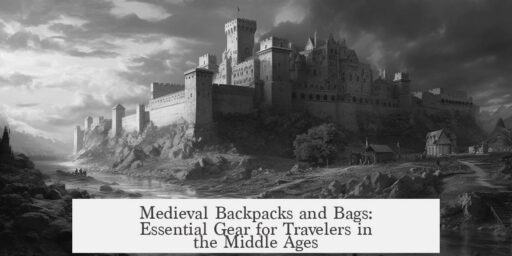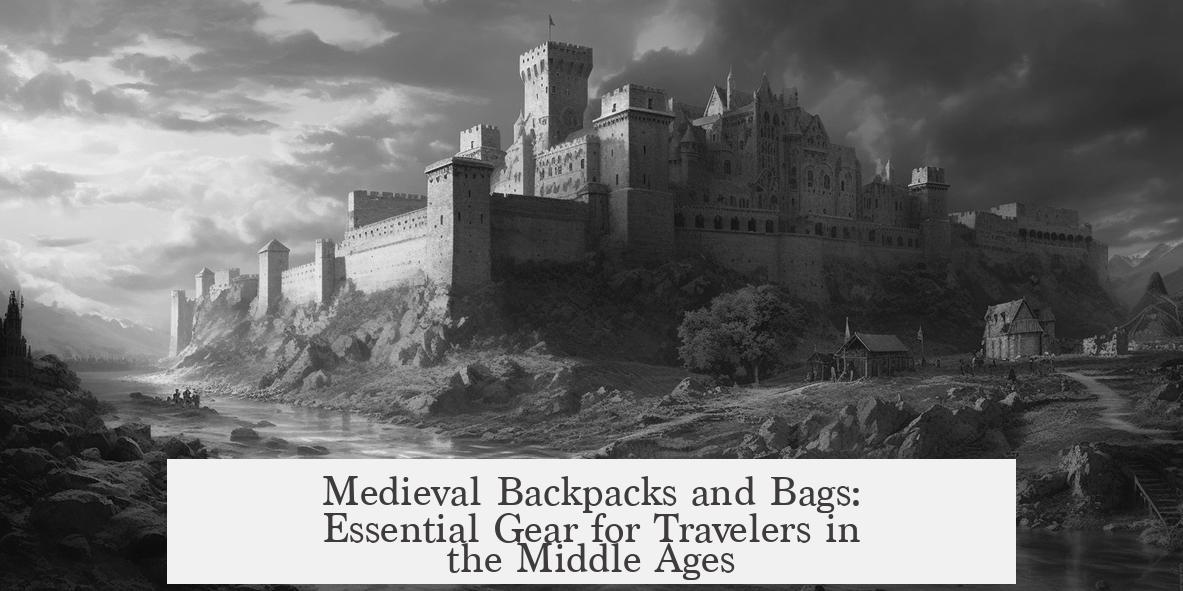Medieval backpacks and bags comprised various designs adapted to the era’s practical needs and cultural contexts. Small personal baggage mostly used belt bags, while larger shoulder satchels served pilgrims and travelers. Frame-style backpacks with wooden structures also existed, though all-cloth backpacks were uncommon. Different methods carried bulkier loads, reflecting diverse medieval transport solutions.
Smaller bags commonly attached to belts featured two main types. The first is a sturdier hinged bag with loops, which secured the bag firmly to a belt. The second type includes simple drawstring pouches hanging from belts. These pouches served in place of pockets, which medieval clothing often lacked. Such belt bags allowed daily carry of essential items, reflecting convenience in medieval attire.
For larger personal baggage, pilgrims used leather shoulder satchels. Medieval art frequently depicts pilgrims carrying these satchels, often decorated with the scallop-shell symbol. The scallop shell represents pilgrimage to Santiago de Compostela, a major medieval pilgrimage destination. This iconography helped identify pilgrims visually in manuscripts and paintings.
Other examples from biblical scenes show Jesus and his apostles carrying shoulder satchels. Jesus’ satchel is small and purse-like, while the disciples’ bags are larger and sometimes made of lighter materials like canvas. These variations indicate evolving bag sizes in response to fashion and traveler demands through the 15th century.
Shoulder bags also symbolized traveling lightly in art. Manuscripts use them to denote pilgrims with minimal baggage. However, it seems unlikely that all pilgrims traveled with only such scant baggage or that these bags belonged exclusively to pilgrims. This symbolism served practical iconography rather than strict historical accuracy.
Today, reenactors reconstruct 15th-century pilgrim outfits, often including shoulder satchels faithful to historical sources. These reconstructions contribute to a better understanding of form, size, materials, and usage of medieval bags.
For transporting larger or bulkier items, medieval people adopted various methods. Soldiers sometimes slung baggage on poles or polearms, or packed goods in net bags. Items could be bound tightly with ropes, allowing easier manual carriage. Rectangular sacks, similar to grain sacks, were another makeshift solution for hauling goods when needed.
Medieval field laborers and produce haulers used pack baskets made from woven materials. These baskets featured straps and were part of the backpack family, offering a sturdy way to carry loads. Several examples from the 15th century confirm their common use in rural and market contexts. However, backpacks made solely of cloth are rare in the historical record.
Frame-style backpacks, often built with wooden frames attached to straps, appear well before the 15th century. Some included canvas covers or left the wooden frame exposed. These backpacks are documented throughout the medieval period and resemble modern hiking and mountaineering styles. Their continued use reflects their practical effectiveness for carrying loads over long distances.
Resources for deeper research on medieval backpack and bag types include scholarly and reenactment works: Christian Folini and John Howe’s article “On Carrying Things: Packs, Baskets, Bags, and Bundles” offers detailed analysis. The website Larsdatter provides images and artifact descriptions under sections such as Pouches & Purses, Pilgrims’ Bags, and Baskets.
Archaeological literature contributes crucial insights, notably Olaf Goubitz’s “Purses In Pieces,” which examines recovered fragments of medieval bags. Additional texts on medieval textiles enrich understanding of materials and construction techniques used in bag-making.
It is important to approach reenactor projects with discernment. The range of historical accuracy varies greatly, from imaginative modern designs to thoroughly researched reproductions rooted in archaeological evidence and period sources. Reliable reconstructions help clarify medieval bag forms and uses.
- Small personal bags mostly took the form of belt bags or pouches for daily essentials.
- Larger shoulder satchels identified pilgrims and travelers; decorated bags showed cultural symbols like the scallop shell.
- Frame-style wooden backpacks existed, often combined with canvas, showing continuity from earlier periods.
- Bulkier baggage moved by various means including sacks, net bags, poles, and woven pack baskets.
- All-cloth backpacks are rare in medieval contexts, with most heavy loads requiring structural support.
- Research draws on medieval art, archaeological finds, scholarly articles, and reenactment reconstructions.




